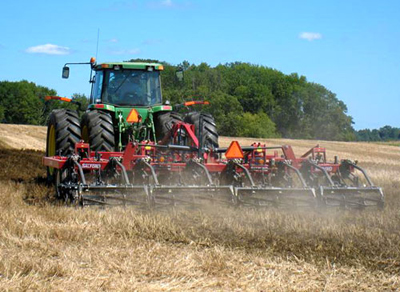Should I remove corn stover this fall?
Removing corn stover has become a common question from producers looking for ways to manage corn residue. Join us for a field day October 4 that will focus on corn residue management.
 Residue management in corn fields is becoming an increasingly important management issue. Improved genetics have resulted in more above ground biomass (corn stover). For sandy soils that are low in organic matter, this is a positive thing. For heavier soils, the high amount of residue can keep the soil cool longer into the spring and create a matte or barrier hindering soybean seed germination the following year. Stover can be managed by tillage or harvest (removal).
Residue management in corn fields is becoming an increasingly important management issue. Improved genetics have resulted in more above ground biomass (corn stover). For sandy soils that are low in organic matter, this is a positive thing. For heavier soils, the high amount of residue can keep the soil cool longer into the spring and create a matte or barrier hindering soybean seed germination the following year. Stover can be managed by tillage or harvest (removal).
So, what is best for your farm?
First, look at the cropping system and determine if the corn stover is more valuable left on the field or removed. Corn stover returns nutrients and organic matter to the soil, so managing the breakdown can help to build soil quality. A dry ton of corn stover will typically contain 22, 8 and 32 pounds of N, P2O5 and K2O respectively, so the value of these nutrients should be accounted for in the price received for the stover. Stover also has value as a feedstock for bioenergy production and livestock feed, so there may be local markets. If corn stover is removed, look for ways to restore nutrients and organic matter. Manure and cover crops can be used in cropping systems to achieve this. Many factors come into play when determining how to manage corn stover on your farm. Each farm’s cropping system will determine what works best.
Determining whether to harvest stover this fall is even more important with the drought. Livestock producers are looking for additional forage and corn stover is an abundant, potential source. How much stover can be removed should be based on a number of factors including tillage operations, soil organic matter content, cropping history and future crops, equipment availability to harvest stover, use of cover crop, application of manure and the economics of each of these factors.
See demonstrations and talk with researchers about corn residue management and bioenergy production at the Bioenergy, Cover Crop and Corn Residue Management field day. The field day will be held at the St. Johns Bioenergy Research Farm on October 4 from 1 to 5 p.m. The farm is located on Scott Road, just north of M-21 in St. Johns, Mich. (view map).
Throughout the afternoon, researchers will discuss corn residue management as well as bioenergy and cover crops. Biomass harvest and bioenergy processing demonstration will be held. Equipment demonstrations including vertical tillage, chopping corn heads, corn stover harvest and cover crop establishment with slurry manure seeding will be conducted.
The field day is hosted by Michigan State University Extension and sponsored by the Michigan Soybean Checkoff program.
Additional resources:
- MSU Extension’s Drought Resources



 Print
Print Email
Email